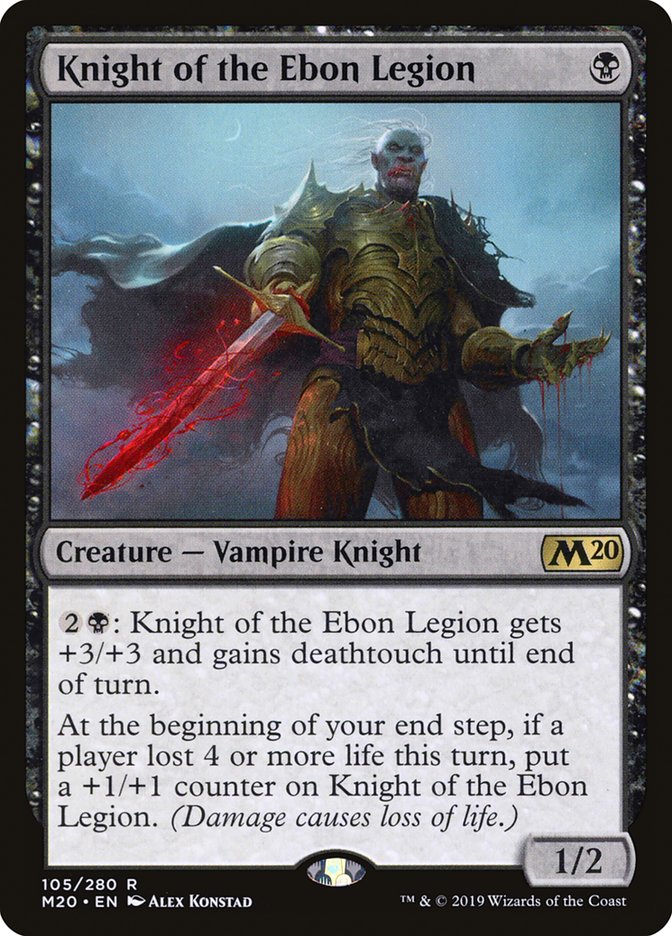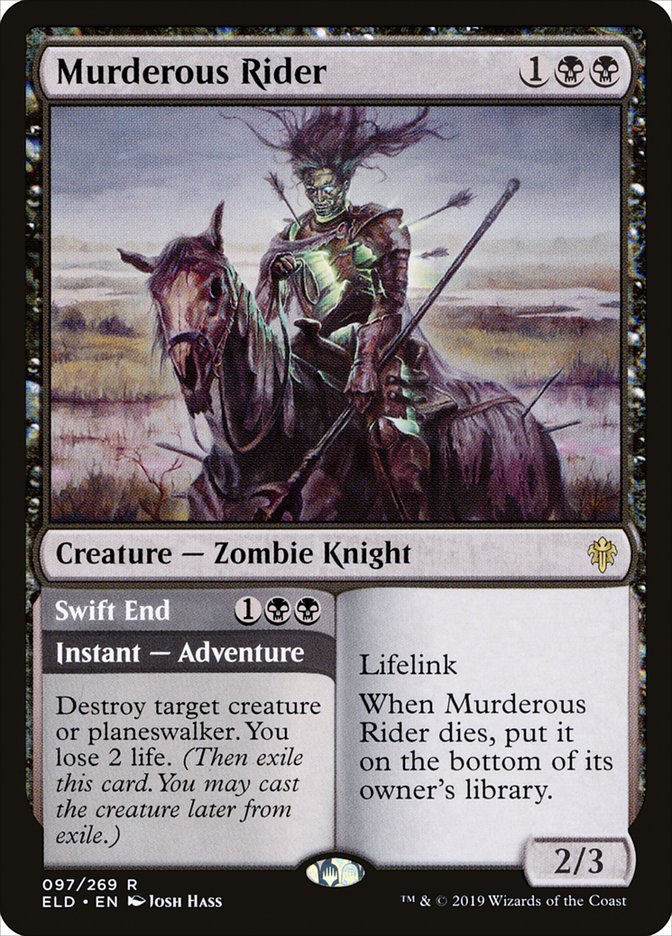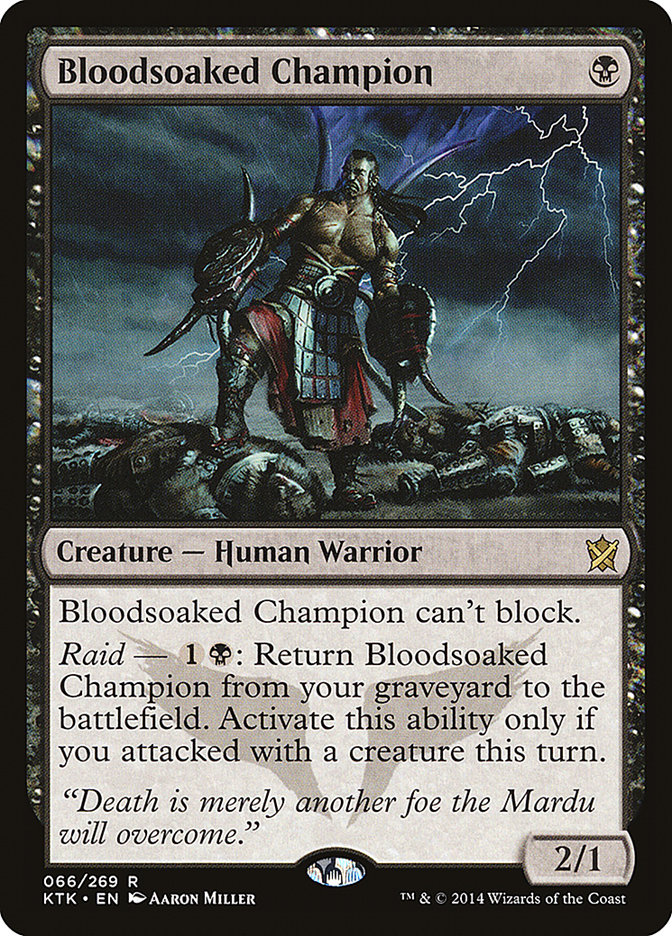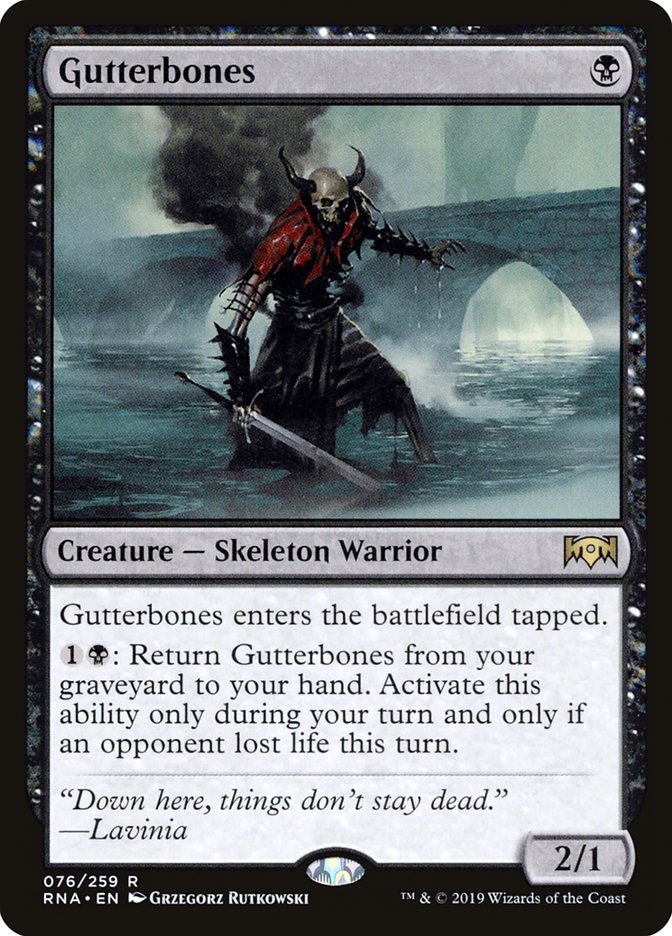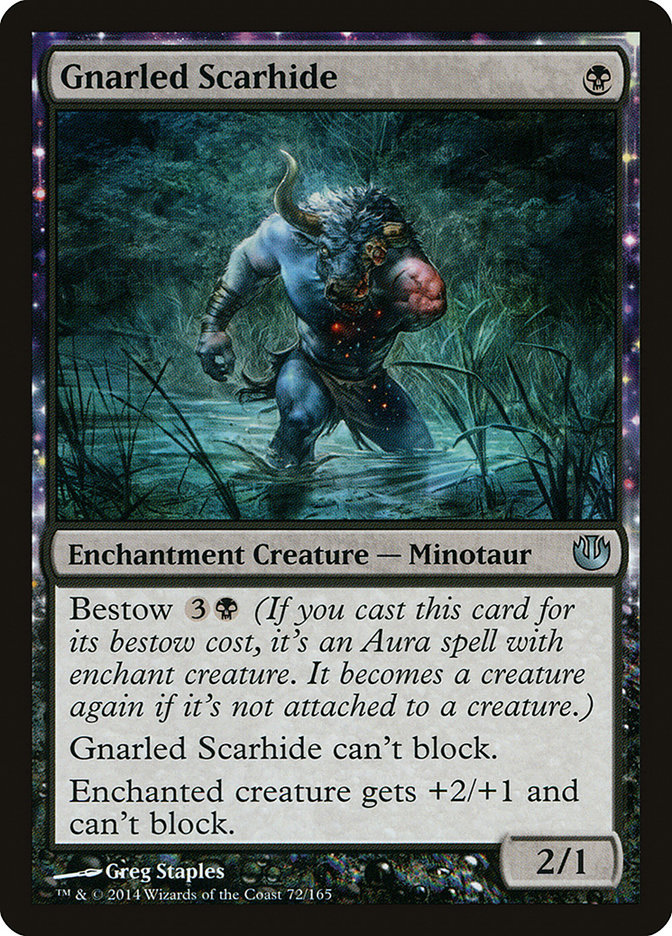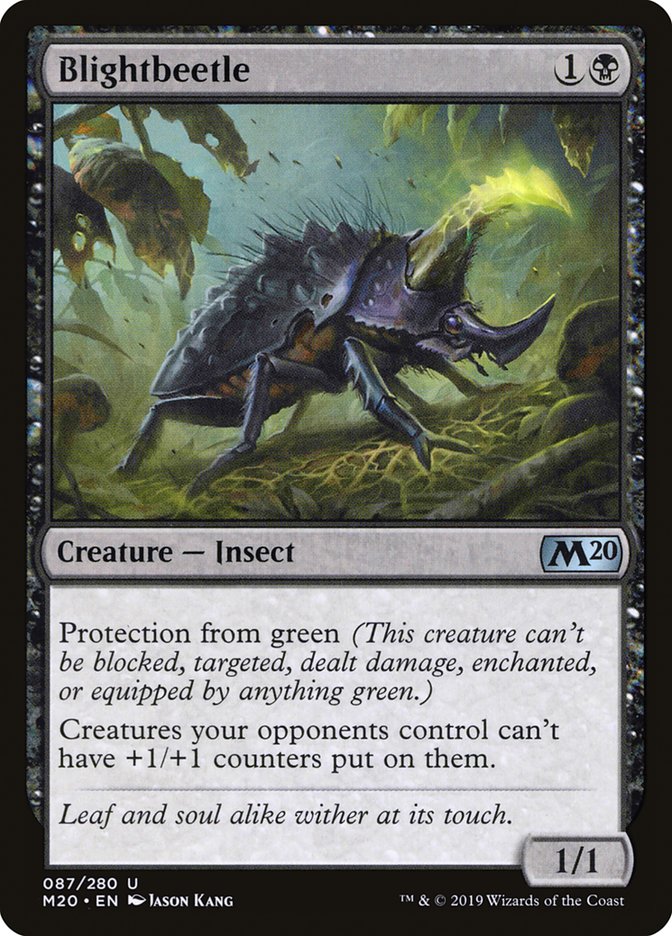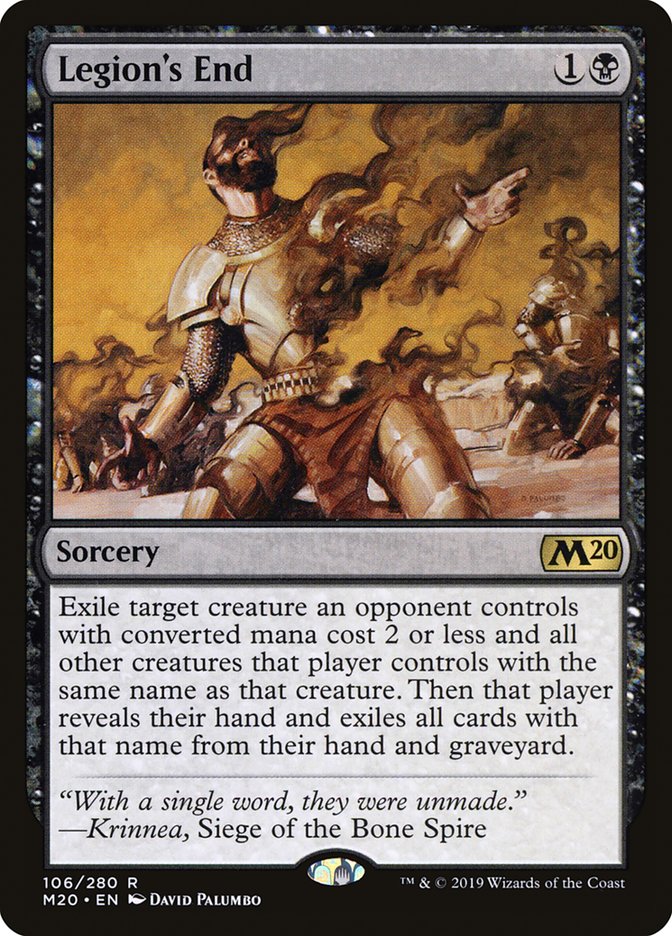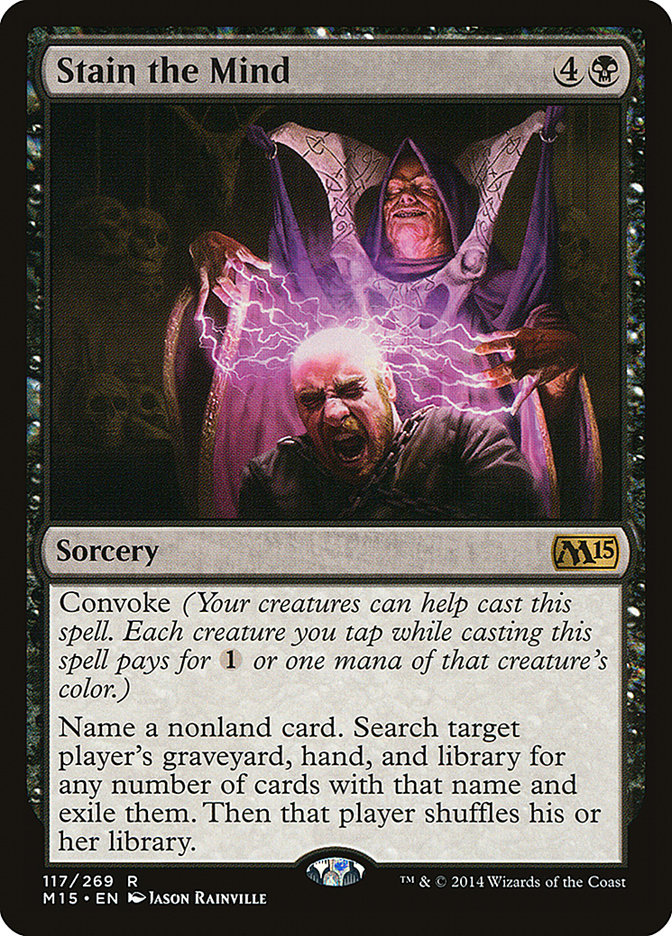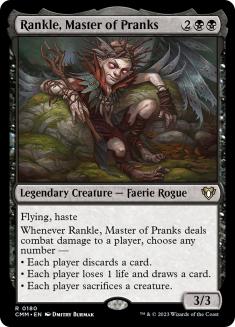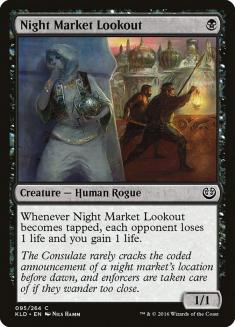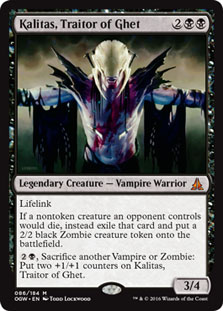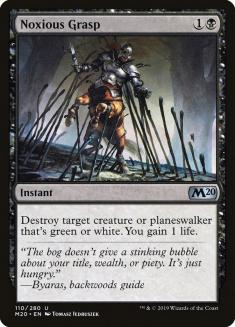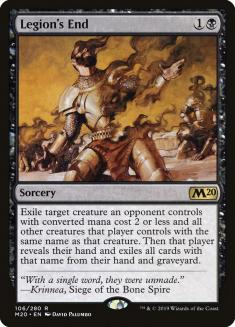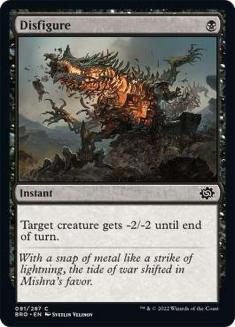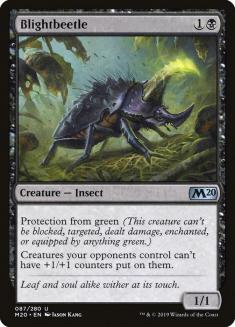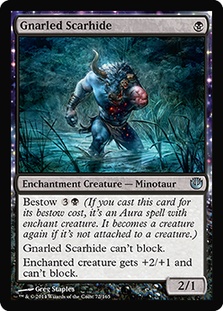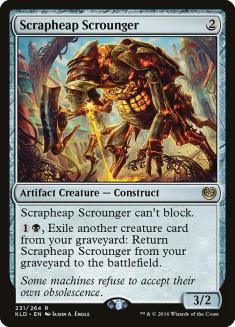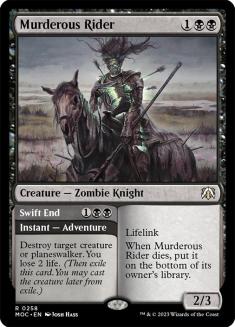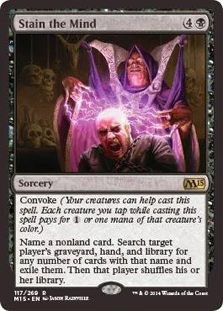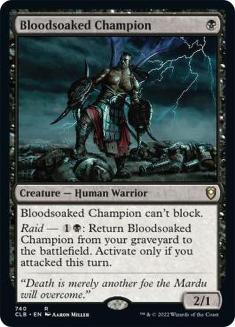After the banning of Felidar Guardian, Oath of Nissa, and Leyline of Abundance, it became clear that aggressive decks were taking over Pioneer, and Smuggler’s Copter is the card that drives most aggressive decks in the format. It’s an incredible rate for an aggressive creature and provides much-needed card selection so that you don’t run out of gas too quickly, or you can dig for a key piece of removal or a burn spell to finish off the game.
The first Smuggler’s Copter deck I tried was Izzet Ensoul, which is a natural fit given the deck’s use of artifact synergies and use of weak artifact creatures to crew it. It’s also a nice target for the Ensoul effects since you no longer have to crew the Vehicle but still get the benefit of flying and the looting trigger. I was close to playing Izzet Ensoul at the Season One Invitational last weekend, but another deck kept sticking out in the back of my mind:
Creatures (24)
- 4 Bloodsoaked Champion
- 4 Scrapheap Scrounger
- 4 Night Market Lookout
- 1 Gutterbones
- 4 Knight of the Ebon Legion
- 3 Rankle, Master of Pranks
- 4 Murderous Rider
Lands (24)
Spells (12)
Sideboard

There’s a lot going on in this deck that I like. The curve is low, ensuring that you will either establish a strong battlefield or interact profitably with your opponent on the first three turns of the game. But despite the low curve, you have a ton to do with your mana if the game goes long. Knight of the Ebon Legion, Murderous Rider, Scrapheap Scrounger, and Bloodsoaked Champion are all mana sinks, and you also get eight utility lands in Mutavault and Castle Locthwain. You can also discard extra lands to Smuggler’s Copter when your draw is threat-light.
All of these things contribute to the deck’s relatively high land count at 24, but that combination of mana sinks and a high land count is something I love in an aggressive strategy, because it means I’ll rarely miss land drops early but also won’t run out of gas in the late-game. Mono-Black Aggro matches the consistency of the various green decks that populate the metagame, even without access to the overpowered Once Upon a Time.
And then of course we have Smuggler’s Copter, which does more in this deck than in any other. Because you have so many recursive threats, the looting trigger generates actual card advantage in this deck, letting you keep extra lands and take full advantage of all your mana sinks without sacrificing any threats. Consider the following sequence:
- Turn 1: Night Market Lookout
- Turn 2: Smuggler’s Copter
- Turn 3: Fatal Push or Thoughtseize, crew Smuggler’s Copter and attack, discard Bloodsoaked Champion to Copter, recur Bloodsoaked Champion.
This curve deals six damage, gains two life, draws an extra card and generates three threats and a piece of interaction, all in the first three turns. Any follow-up creature to crew the Copter lets you make an attack for seven, threatening lethal damage on Turn 5, which is a fine goldfish, but this deck is doing that while also interacting and generating card advantage. The ability to generate card advantage without losing tempo is my number one sign of a great deck, and after testing with it, I decided to play it over Izzet Ensoul, even though I was more experienced with the artifact deck.
The PTQ-winning list was well-constructed, but there were two small areas I saw for potential improvement. The first was in the last maindeck slot, which was a Gutterbones. I liked the idea of an additional one-drop to keep the curve low, but Gutterbones has two major issues. The first is that, as a ninth recursive creature, you start to hit on diminishing returns, as you find yourself without the spare mana to activate all of them in a timely fashion. Second is that, by virtue of entering the battlefield tapped, it’s bad for crewing Smuggler’s Copter, and given how important that card is to the deck, I wanted to make every slot count for maximizing its efficacy.
Fortunately, there are plenty of solid aggressive creatures to choose from in Pioneer. After a Gatherer search, I landed on Shadow Alley Denizen and Gnarled Scarhide as potential options. The Denizen offers some easy evasion, which helps you attack through big green creatures or other annoying blockers like Reflector Mage but ultimately isn’t that powerful, especially when topdecked in the mid- to late-game.
Gnarled Scarhide is straightforward in what it does, and you won’t bestow it very often, but when you do it’ll be very important. The one time I bestowed Scarhide last weekend it was on a Smuggler’s Copter so I could attack down an Oko, Thief of Crowns. It’s also even better against Supreme Verdict, since the Aura will revert back to a creature, leaving you an attacker to immediately crew a Smuggler’s Copter or recur any Bloodsoaked Champions that died. If cards like Blazing Volley and Golgari Charm become more popular, you might want to look for another creature with two toughness in that slot, like Rakdos Cackler, but for now I like the Scarhide.
The second area for improvement was the sideboard. Kitesail Freebooter was overkill in a metagame with lots of aggro decks, and Ruin Raider struck me as a relatively weak card, so I had four slots to play with, ultimately settling on two Blightbeetle, one Legion’s End, and one Stain the Mind in those slots.
The Blightbeetles are an obvious nod to Mono-Green Devotion and Hardened Scales, which, based on the mad search for Vivien, Arkbow Rangers that played out on Twitter leading up to the event, I expected would be quite popular. The Devotion deck struggles particularly with the card, since it can only be removed by a Walking Ballista which is already on the battlefield and stop most of their cards from doing much of anything, though notably Nissa, Who Shakes the World still functions as normal. I don’t bring the card in against the green aggro decks, since it doesn’t block Steel Leaf Champion or Questing Beast.
The Stain the Mind was my nod to the uncertainty that still remains in Pioneer. It can completely shut down combo decks like Jeskai Ascendancy or Possibility Storm[/author]“][author name="Possibility Storm"]Possibility Storm[/author] while still being quite effective against normal control decks. It was excellent the few times I cast it on the weekend, and I plan on keeping it around, but if the metagame gets more aggro-heavy, it’s easily cuttable.
The Legion’s End was a nod to both the mirror and Field of the Dead decks, which I expected to perform well. I was correct on both counts, and my first step moving forward is to find space for more copies. The third Noxious Grasp, the fourth Duress, and the singleton Stain the Mind are candidates to cut to make that space.
With those changes, I registered the following list:
Creatures (24)
- 1 Gnarled Scarhide
- 4 Bloodsoaked Champion
- 4 Scrapheap Scrounger
- 4 Night Market Lookout
- 4 Knight of the Ebon Legion
- 3 Rankle, Master of Pranks
- 4 Murderous Rider
Lands (24)
Spells (12)
Sideboard

After a 7-1 run in the Pioneer portion of the Season Two Invitational and a 4-1 record in the Sunday Pioneer PTQ, I don’t have much to change, but I will say that Rankle, Master of Pranks didn’t impress me as much as when I first picked up the deck. There weren’t a lot of planeswalkers around, and at four mana it could be clunky and lead to significant tempo losses against Lightning Strike, Petty Theft, and other commonly played interactive cards.
Moving forward, I’d like to try Rotting Regisaur in that slot. Its body can contend in combat with other aggressive decks, including the green-based variants, and it puts a ton of pressure on control and combo. The ability is often mitigated by discarding recursive creatures until your hand is empty, though it makes it difficult to hold removal spells in the mid-game.
Playing with Mono-Black Aggro
Mono-Black Aggro is an aggro deck, but not in the same sense that Mono-Red and Simic Aggro are. Because of its quality removal and recursive threats, it can play an attrition game much better than other aggro decks, but there’s an important caveat to that fact – in order to play that attrition game, you need to get your Bloodsoaked Champions and Scrapheap Scroungers into combat. Neither creature blocks, so in order to get them into combat, you need to be attacking and making your opponent block.
We normally think of attrition strategies as playing reactively and falling behind in the early-game while setting up to win the late-game. Mono-Black Aggro sets up to win the late-game by getting ahead in the early-game so that your opponent can’t simply race your recursive threats and is instead forced to interact with them. That means you don’t want to fall behind early by keeping a weak hand, especially on the draw. It also means that you should be selective with your removal. Try to trade your recursive threats with your opponent’s smaller creatures rather than using removal to push through extra damage. As long as you keep their more powerful creatures off the battlefield, you’ll overwhelm them later when your threats come back and theirs don’t.
Of course, there are decks that do have inevitability over a bunch of recurring 2/1s and 3/2s. Decks like Bant Ramp and Simic Nexus will win the late-game, so in those matchups you’ll want to play out more like a traditional aggro deck. Fortunately these decks don’t put out many blockers, so you’re able to do so rather easily.
Sideboard Guide
VS Mono-Green Devotion
Out:
In:
In this matchup, you shift to a more controlling role since you aren’t fast enough to race them. In that plan, Kalitas outperforms Rankle by supercharging all your removal. It also means the games go longer, where Thoughtseize is a poor topdeck, so it comes out. Prioritize keeping their planeswalkers in check and keeping Walking Ballista off the battlefield so Blightbeetle is lights-out it if lands. Night Market Lookout is the worst creature in combat so it’s the first one to cut in creature matchups.
Out:
In:
Similar to Mono-Green Devotion, but with the additional caveat that you should remove Winding Constrictor when possible and not put as much faith in Blightbeetle, since they can remove it with Fatal Push.
VS Simic Aggro
Out:
In:
As noted earlier, Blightbeetle is weak here since it doesn’t block Steel Leaf Champion or Questing Beast. Their creatures dominate yours in combat, so removing the first few is very important because you need to make it hard for them to take an aggressive posture.
VS Mono-Black Aggro
Out:
In:
Smuggler’s Copter and Kalitas, Traitor of Ghet are dominant here because of the card advantage they generate, so save removal for them whenever possible. In the late-game, Knight of the Ebon Legion dominates combat and becomes important to remove as well.
VS Mono-Red Aggro
Out:
In:
Most red lists are spell-heavy enough that Duress is effective, but if yours is more creature-oriented I’d leave in more creatures and potentially some Thoughtseizes if they have high-impact creatures like Goblin Chainwhirler. They’re the more aggressive deck in the matchup, so take a defensive posture, but try to sneak in damage when you can so you can turn the corner as soon as possible and minimize the time they have to topdeck lethal burn.
VS Bant Ramp
Out:
In:
Most Bant Ramp lists have very few targets for your removal, so I want to remove as much as possible. Noxious Grasp is more efficient than Swift End and Murderous Rider is a weak body, so I’d rather have the better removal spell to remove a blocker. Stain the Mind mostly names Supreme Verdict or Hour of Promise, depending on which you’re more fearful of. Add Hour of Revelation to that list if they have it. They have enough disruption that you usually don’t kill them before Field comes online, so your evasive threats are important for closing the game.
VS Izzet Ensoul
Out:
In:
Keeping their Ensoul effects in check and trying to stay out of Shrapnel Blast range is what’s important here, which is why I like keeping in some Thoughtseizes. I also consider chump blocking an Ensouled creature I have an answer for once I untap; your higher card quality will take over a long game, so you really don’t want to get cheesed out early. You have little recourse against Ensoul on Darksteel Citadel, though notably Legion’s End takes care of it – yet another reason to add more copies.
VS Izzet Phoenix
Out:
In:
If your opponent has Crackling Drake I’d likely leave in Thoughtseize over Duress, but without it the only good target is Thing in the Ice, so saving the life makes sense. You don’t want to overload on discard spells because a topdecked Treasure Cruise becomes too devastating. Prioritize answering Thing in the Ice since you can effectively race Arclight Phoenix and grind with it if they try to play defense.
VS Azorius Flash
Out:
In:
I prefer Rankle to Kalitas here since the latter is much worse against the myriad bounce effects in the Flash deck. The games they win are ones where they keep you off-balance and find a spot to turn the corner with Archangel Avacyn and Brazen Borrower. The former is a top priority for your removal, and the potential for a transformation means you want to keep Teferi, Time Raveler off the battlefield so you can respond to the trigger. The importance of Brazen Borrower makes me consider Disfigure here, but they have so many 2/3s I have yet to pull the trigger.
VS Simic Nexus
Out:
In:
I like Legion’s End because they almost always use Thing in the Ice as their sideboard win condition, so adjust if your opponent is using a different threat. Also, normally I’d trim Scrapheap Scrounger to keep the curve as low as possible, but here you want to diversify your curve to play around Blast Zone.
Usually you’ll have an idea of what’s in their hand from an early Thoughtseize or Duress, so if you have Stain the Mind you should judge whether they are more stymied on mana or card draw effects, and try to cut them off of what they are most starved for. If it’s close, keep in mind that the more pressure you have, the more it makes sense to cut off their mana.
I like to fire off the point discard early enough to tag Search for Azcanta, since it’s one of the best cards at helping them fix their draws to play through your disruption.
Mono-Black Aggro was the breakout deck of the weekend, so it’ll undoubtedly see a lot of hate in the coming week, but it has the combination of speed, power, and versatility to combat that hate. Smuggler’s Copter is one of the five best cards in Pioneer, so there will always be room for decks that utilize that card so well.



